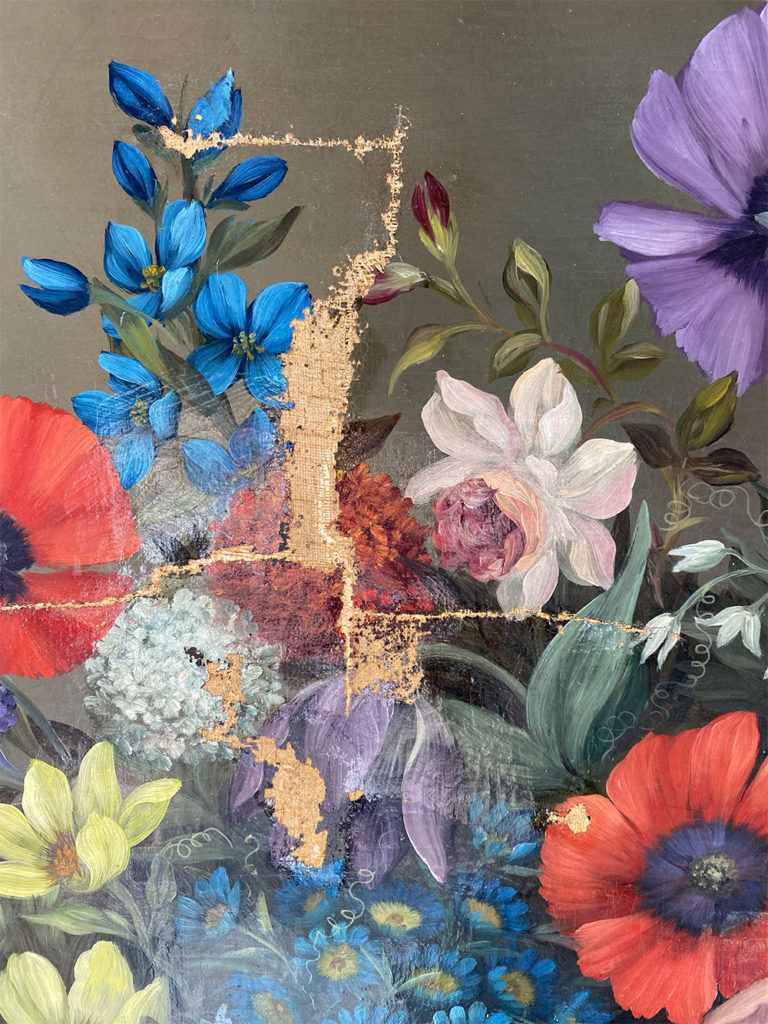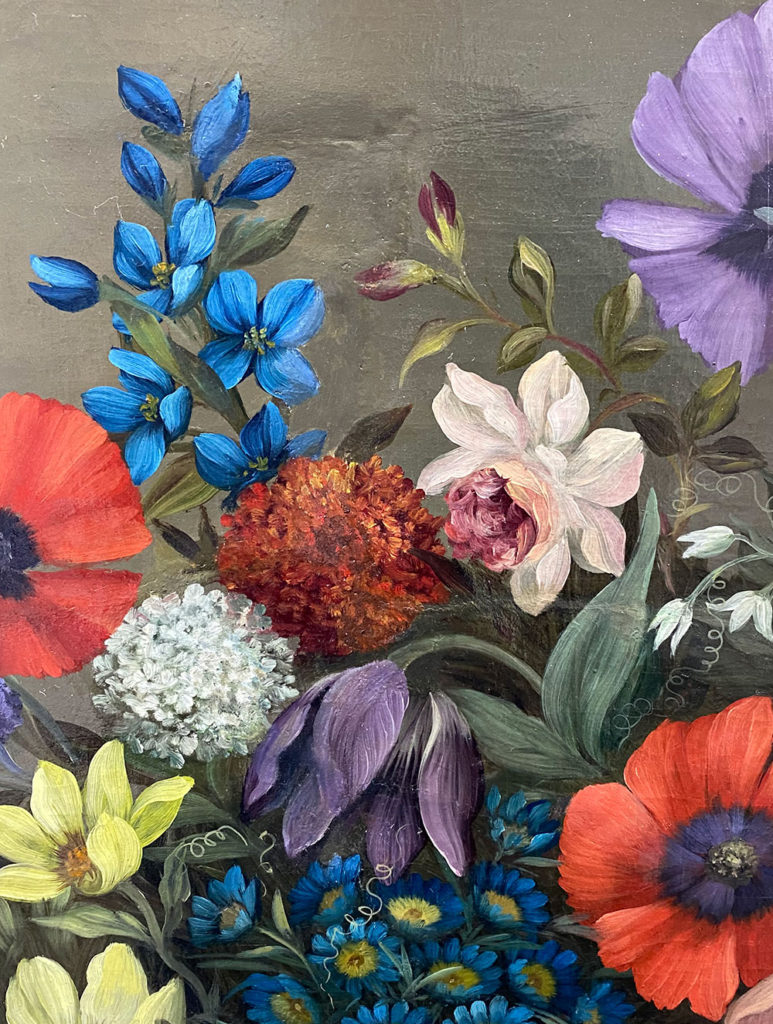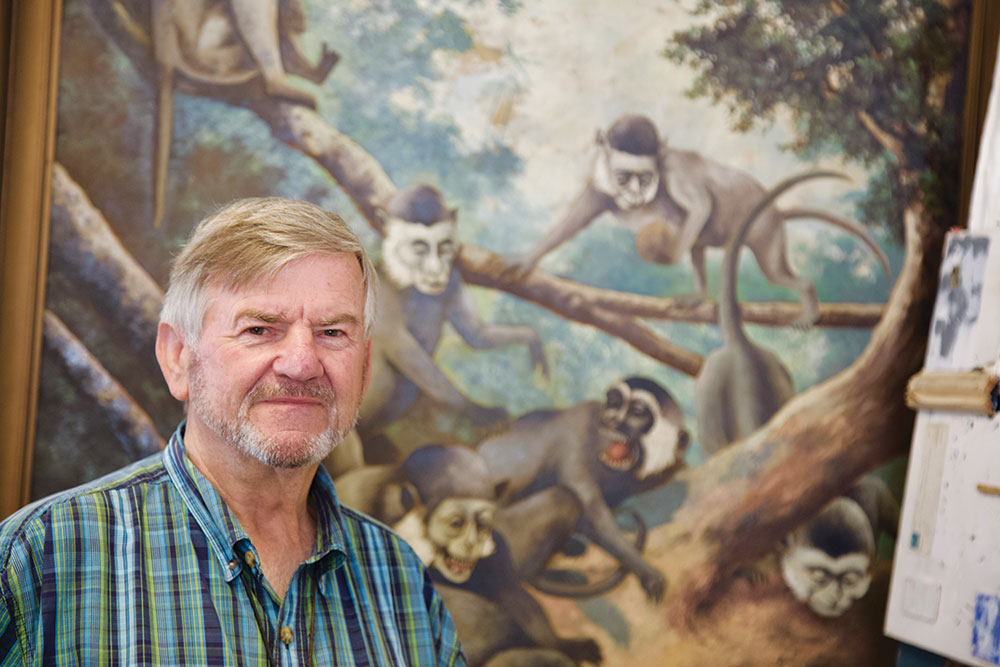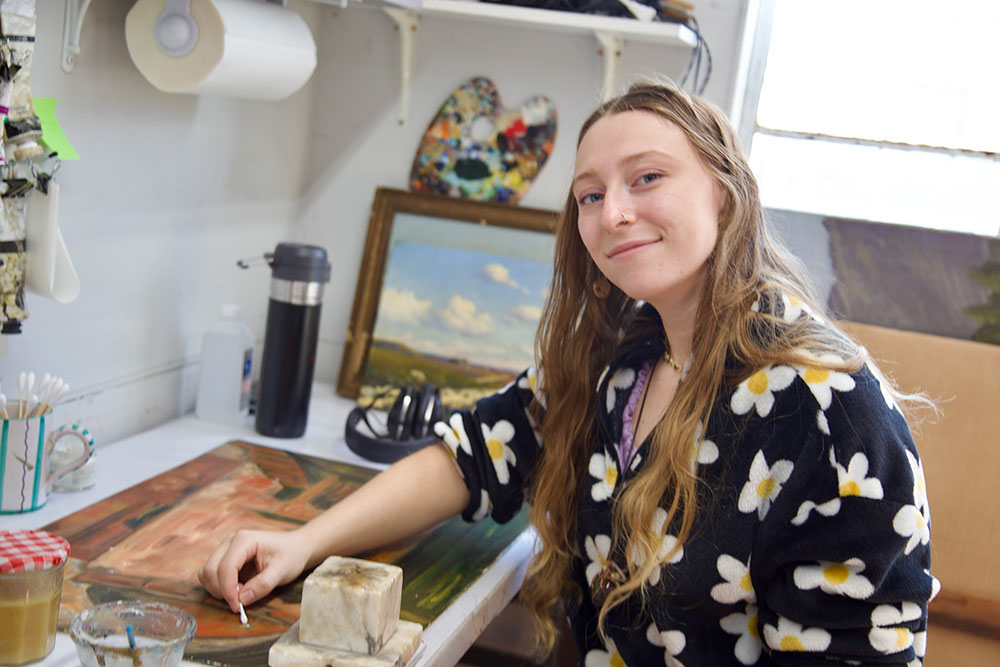The studio gallery of Robert Azensky Fine Art in the heart of Soquel, internationally known as a place to have art restored to its original state, is a place full of wonders, filled with centuries-old collectable treasures, and art—so much art, of every style and subject.
From California landscapes to Surrealist dreamscapes, modern abstracts to mythical pre-Raphaelites, you’ll find it here. Every piece that arrives has one of two stories: either it has been adored for decades or neglected for far too many, and the job of the artists who work magic here is to write the next chapter while reversing time, restoring history for a range of prices up to $40,000—in a building that was once a meat locker.


FORWARD INTO THE PAST
In his khaki cargo shorts, Robert Azensky appears more like a character from an Indiana Jones movie than a dealer in fine art—not surprising, from his decades spent in the world of antiques and lost treasures.
In the early days, Azensky didn’t set out to become an art dealer. “I was a real estate agent and then an antique dealer,” he says.
A life-changing moment came when he fell in love with an entire collection of abstract art, the beginning of a new passion for buying and selling paintings and sculpture.
When a lease expired on an early gallery, Azensky was at a crossroads in his career, weighing his options. He could open a new gallery, return to antique street fairs, or take his chances in the emerging world of online auctions. He tried listing paintings on eBay and similar sites—but sales came slowly.
Then he noticed a respected dealer carrying stacks of paintings at a flea market, priced at $20 or $30 each. Curious, Azensky discovered that the man was selling them through One Kings Lane, a high-end marketplace known for designer décor. The discovery was a revelation.
“I called them and they said, ‘We don’t want your antiques—we want your art,’” Azensky says. At the time he had some 3,500 paintings in stock. Within weeks, he was slowly uploading pieces to the platform, learning as he went.
Fate stepped in upon a chance encounter with Diana Wilson, a friend from local trivia nights. “We’d crossed paths before. She’s very striking—blonde hair, with a glass of Chardonnay,” he remembers. “I told her I was over my head with my online art business, and she said, ‘Maybe I can help.’”
She could—and did. Wilson introduced structure to the chaos. “She got an Excel program going, cataloged everything, numbered every piece. We had hundreds stacked against the wall,” Azensky says. “Within a few months we were assigning 20 to 30 paintings a week to One Kings Lane.”
Azensky even taught himself restoration.
“When you’ve got hundreds of paintings and they’re yours, you learn how,” he laughs. “I tried different cleaners, did some research, wrecked a couple pieces—but you learn. I once cleaned what I thought was a nocturne—a night scene—and after I sold it, I saw it in another gallery. It was a sunrise. They’d cleaned it properly.”
Together the pair built a sustainable rhythm: Azensky’s deep knowledge of art history and pricing paired with Wilson’s logistical discipline. The secret, he says, is “knowing what to buy, how to buy—that comes from 37 years of learning, trial and error.”

A DAY, A LIFE, IN ART
Wilson, the studio’s conservator and restorationist, examines her current restoration work in progress, assessing its accuracy. Her standard for releasing a finished work is plain: “If I can see the fix, it’s not done,” she says.
Wilson’s path into the gallery began on the marketing side, teaming with Azensky after a long career in tech, working for Intel, Google and Microsoft.
Fifteen years in, she is a member of the American Institute for Conservation. She loves the work of restoration and the hunt for new additions to the collection. She scouts widely, sometimes finding worthy pieces in unglamorous corners of the internet, like an oil by the renowned American painter William Coulter, found on Shop Goodwill.
She describes herself as unusually sensitive to color and detail, with “a memory for color” that’s been there since childhood. It’s a talent that made restoring and conserving art a natural evolution.
Practicing the art came first; chemistry came later. Learning solvents, varnishes, and the structural side—relining, mending, stabilizing—was the steep slope she had to climb.
What helped was a mix of formal community and visual learning: the knowledge exchange through the American Institute for Conservation’s forums, and the very practical reality of watching procedures via video when a demonstration clarified more than a paragraph ever could.
She’s candid about starting on lower-value pieces and learning by doing. The through-line is patience and pace: most work happens in tiny increments, mere inches at a time, with constant checks to be sure nothing is lifting or reacting badly.
“You have to be a marathoner. The more valuable the painting, the more likely we are to invest time in it,” she says, recalling a John Charlton that occupied her—on and off—for three years.
Wilson works on restoring oils, and explains how her Ben Lomond-based colleague Lina Pukstaite, museum-trained, specializes in paper.
“That’s like next-level alchemy,” she says. “There’s no margin for error. None. That’s heart-stopping stuff to me.”
FINDING FAKES
In the art world, reproductions abound—some honest, others deceptively convincing. With every work, the studio vets authenticity with method and consensus.
Research is essential, into artist palettes, subject matter, signatures, period trends and provenance trails. If the team is not unanimously in agreement, a work doesn’t go forward as advertised.
Wilson points to a recent case involving days spent in the UC Berkeley library cross-checking a Paul Klee catalog raisonné, then translating non-illustrated entries to see if a work might match by description and size. Even when passing a first inspection, Wilson stresses, that’s not enough on its own.
“Our reputation is on the line,” she says.

REVEALING MICHELANGELO
The oldest forms of “repair” were crude: monks repainting icons, framers repairing canvases, early conservators replacing missing bits in a mural. Over centuries the craft grew more refined. By the 19th and early 20th centuries, the practice became more exacting—introduce a varnish, test solvents, isolate layers, document everything.
In 1980, scaffolding began to climb the walls of the Vatican’s most sacred chamber. Above it, Michelangelo’s ceiling—painted between 1508 and 1512—had darkened into a fog of soot, candle smoke and centuries of varnish. To many, this dimness was part of their grandeur. To a handful of restorers led by Gianluigi Colalucci, it was a veil that needed to be lifted. Under the supervision of the Vatican’s Laboratory for the Restoration of Pictures they tested patch after patch of the frescoes, recording the reaction of every pigment. Each test square became a miniature window into the 16th century.
When the first panels were unveiled, the world gasped. Michelangelo, it turned out, had painted in fierce, luminous color—closer to modern comic art than the sepia solemnity people had imagined.
What emerged was not just a restored masterpiece but a shift in philosophy. The Sistine project became a benchmark for modern conservation. Every solvent was tested, every intervention recorded, and every decision framed around reversibility—the ability to undo any treatment in the future. Colalucci’s team even left small “control patches” untouched as a record of the past and proof of their restraint.
Robert Azensky’s workshop reflects this lineage. The gallery thrives in the world of buying and selling of art, but they’re not just picking treasures, they’re rescuing them.

ART NECROMANCY
Art restoration specialist Katlyn/Kiara Leonardich, 23, a San Jose State art grad, is immersed in repairing a reproduction of Tarquinius and Lucretia, originally painted by the 16th-century Italian artist Titian. Her brush, dabbed with a perfectly matched flesh tone, restores the color of Lucretia’s arm, whose hand clutches a dagger meant for herself.
Leonardich brings both a steady hand and a bright-eyed fascination to her work. Her roots run deep in art—drawing since third grade, when library books on “how to draw horses” filled her afternoons.
Raised first in a tiny Sierra Nevada mountain town and later in the Santa Cruz Mountains, she eventually graduated from Los Gatos High after years of cramming her schedule with every art class she could find. Encouraged by teachers and parents, she spent every spare hour in studios and summer programs, eventually earning her art degree from San José State after briefly considering a career in teaching.
When she’s not restoring century-old paintings, she still keeps her playful side alive—working weekends as a face painter at birthday parties and school festivals, bringing color to kids’ cheeks instead of canvases.
She pursues her own career as an artist, creating worlds from her imagination.
“I love fantasy films and imagery, so when people have a fantastical concept and represent it really well, I’m in love with that, and I want to get there.”
That lifelong love of making art also fuels her work at the gallery’s restoration bench.
Cleaning a painting, she says, can feel like time travel, and the ghost of the original artist’s touch flickers back to life.
“I like knowing the history of things, and when I first started here, I thought a lot about how someone else’s hands once did this—and now I’m touching it,” she says.
“It feels like art necromancy.”
Leonardich learned fast that not every resurrection goes smoothly.
“Within my first week,” she remembers, “I did make kind of a big oopsie when I was applying an iron-on patch on the back of a canvas. I forgot to put something non-stick under it and huge chunks came off on the cardboard beneath.”
Showing her talent and determination, she fixed the damage with patient in-painting. Since then, she’s become ever more confident, even repairing disastrously bad prior “restorations,” tackling everything from questionably wax-filled surfaces to cracked oil paint “repaired” with car-repair bondo.
Still, she admits that some repairs can spike her anxiety.
“We have one painting that honestly, I am still avoiding because the restoration is super difficult. It’s super nerve-wracking because the only way to fix it is possibly damaging the base a little bit, and you want to avoid that at all costs.”

BULLETS AND BLOOM
Every painting that enters a restoration studio comes with its own scars. Some are predictable—grime, varnish gone yellow, paint that has curled and lifted in little waves—but others tell stranger stories. Wilson remembers one in particular.
What had looked like a small puncture was assumed to be accidental damage, until the pattern around it suggested otherwise. The team examined it under magnification, with light raking across the surface. The verdict: a bullet hole! The owners declined the repair, retaining that record of the painting’s life, a part of its story.
Like the scar of a stray bullet, damage sometimes becomes character, the visible record of survival. Some damage threatens to destroy a canvas; much dims the beauty that once breathed through it. Surface cleaning lifts away decades of smoke, candle soot and airborne grime, each pass revealing color that hasn’t been seen in years. Yellowed varnish, once applied to protect the surface, is dissolved in tiny, tested swabs until the true tones reappear.
More urgent are the physical ailments: cupping and lifting, when the paint layer starts to curl or separate from its ground. Each loose flake is stabilized before it can fly free. Abrasion—the faint scuffing where a frame rubbed or an overzealous cleaner once pressed too hard—gets retouched only enough to restore continuity, never disguise history.
Then there’s bloom: a ghostly white haze that can blanket the varnish when moisture or chemical reaction clouds it. Under the right hand and the right solvent, it melts away in seconds, like fog lifting from a window.
And there’s craquelure—the fine network of cracks that time itself inscribes. Most owners assume it’s damage; restorers know it’s personality. Craquelure maps the painting’s life, its expansions and contractions through countless seasons. It’s usually left untouched unless flakes begin to loosen.
As a group, the team leans on the profession’s first principle: “First, do no harm.”
Wilson and her restorers fix what threatens the work and preserve what makes it unique. That includes, occasionally, a bullet hole—proof that even art can survive a little chaos and still be worth keeping.
RESTORATION IN THE VIRTUAL WORLD
Gallery Director Devon Brockopp-Hammer is affectionately described as running “a tight shipwreck.” He oversees the vast online collection of the gallery’s art offerings.
He also plies his art skills digitally, achieving in Photoshop what the restorationists will do in reality. With so many paintings arriving for triage and stored awaiting their chance for renewal, he repairs with pixels and lists the art as it will look, making it available as soon as possible, rather than languishing for months.
The repairs are far more involved than a click of a digital healing brush, requiring knowledge of everything that can and can’t be repaired, but critically, presenting the art as close to reality in natural light.
Devon found the studio through a help-wanted ad, and later reached out to Kiara, a friend from their artists’ Meet-Up. Away from work, his creative passion is music of the experimental kind, often incorporating the technique of “looping.”
GIFTS OF REBIRTH
It’s one thing to wrap a gift. It’s another to bring something back to life.
Nearly every family seems to have a painting quietly aging in the background, or stored away half-forgotten, dulled by dust, damaged, or clouded with varnish.
During the holidays, the team at Azensky studio are often busy receiving those treasures and returning them renewed. Not a new possession, but a restored memory.
Not every canvas in need of rescue was painted by someone famous.
A professional restorer is there for anyone who wants to keep a personal history intact. When they look at an heirloom, they don’t see “low-value art.” They see the same materials that every master once used.
Owners are often astonished by the emotional payoff. A dull gray sky turns cobalt again; a haze of yellow vanishes to reveal pink skin tones that feel almost alive. It’s like hearing a voice you thought was lost.
RESTORER or CONSERVATOR? WHO TO TRUST?
When an old painting darkens with age or flakes from its canvas, the person you call might call themselves a restorer or a conservator—and sometimes both. The difference is subtle but important. A restorer focuses on visual renewal. A conservator is trained to preserve and stabilize with minimal interference.
Most reputable studios, including Azensky’s, blend the two disciplines. For anyone who owns a painted heirloom, the safest path is to seek a professional who honors both arts: conservation for integrity, restoration for beauty.
FINDING JOY
Diana Wilson’s license plate jokes that she’s an “art wizard,” but though everything is not high-stakes oil on canvas, she’s serious about her devotion to everything she restores. The emotional payoff is similar.
“Almost every painting is like a revelation,” she says.
Wilson is surprised that more young artists don’t discover art restoration.
“In terms of work-life balance, this is a wonderful career,” she says.
With a little hired help, her work even allows her to care for her 94-year-old mother. She points to her own experience as proof of the opportunities the work can bring.
“I’m not working 60 hours a week like when I was in tech, plus the commute, which is soul-killing,” she says,
“I’m able to roll in at 11 and leave at 4.”
Even working on a Saturday, she can put on some Rolling Stones and enjoy a mimosa. “And I can live wherever I want to live.”
“But I think more importantly, when I fix the painting something in my soul is fixed,” Wilson says with a look of gratitude. “It just makes sense. The universe is back in balance.”
Scroll through thousands of curated art pieces in the Robert Azensky Collection online at Artsy, Chairish and 1st Dibs. To buy, sell, or plan a restoration of art by appointment, call 831-346-6466 or email, ******************@***il.com“>ro******************@***il.com.











